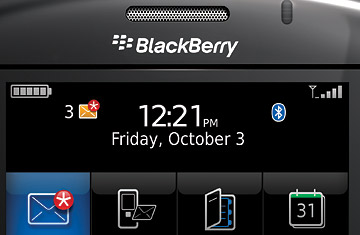
The BlackBerry Storm will be available Nov. 21
The blogosphere is ablaze with news leaks about the BlackBerry Storm, which goes on sale in November. But the stories, which are long on gigabytes, megapixels and other technobabble, give almost no idea of what this new phone is actually like to use. Most notably, they overlook a breakthrough design element that sets the Storm apart from every other iPhone wannabe: its entire 3.2-in. touchscreen doubles as a big clickable button.
I tested the Storm's clickable screen last week when I met with Mike Lazaridis, president and cofounder of Research In Motion (RIM), BlackBerry's maker, in New York City — and I was impressed. You can press the screen to confirm menu choices, launch Web pages and open applications, a novel feature you won't find in other phones. After selecting, say, which e-mail message you want to read, you can open it by gently pressing on the screen — it actually sinks into the casing as you press, with a satisfying "click." The screen functions just like a mouse click or the click of a trackball on other BlackBerry devices and T-Mobile's G1 "Google phone."
The problem with other touchscreen-based phones, says Lazaridis, is that "there's no tactile response — they mix navigation with confirmation." When you try to click a Web link on the iPhone, for example, it's all too easy to accidentally tap the wrong spot and launch the link that was just above or below the one you really wanted. That wastes time, and is especially annoying on a wireless device, whose battery life is precious.
The Storm eliminates that problem with the clickable screen. It further improves the touchscreen experience with two other features designed to separate navigation and confirmation, which, Lazaridis told TIME, is the trademark of the Storm. One is the virtual keyboard: each letter lights up as you tap it so you know instantly whether you hit the right key. The second is the cursor: as you move your finger across the screen, a small arrow — which looks like a mouse cursor — appears to show exactly where your finger is pointed. Then, to confirm your selections, you push down on the entire screen.
What we still don't know about the Storm is how fast and reliably it will connect with Verizon's 3G network. Network speed determines how fast Web pages or file attachments load onto your device. It's especially important for the Storm because it lacks wi-fi connectivity, a feature that had been inaccurately rumored in the blogosphere but which is absent from the final device. (Both the iPhone and the G1 are wi-fi enabled.) Given that Verizon's nationwide 3G network is much more extensive than what's offered by rivals AT&T and T-Mobile (carriers for the iPhone and G1, respectively), it is expected to work fairly well.
The Storm's technical specifications are otherwise solid. Available in blue, sandstone, silver and black, the 5.5-oz. phone features a removable battery and MicroSD slot that can hold up to 16 GB of photos, songs, spreadsheets and more. The phone comes with 1 GB of built-in memory.
Analysts are already forecasting strong interest in the Storm. The BlackBerry brand has an intensely loyal following, thanks to the devices' distinctive security features, such as encrypted e-mail and the ability for corporate IT departments to remotely erase downloaded messages in case of loss or theft. Once a niche player in the handheld market, BlackBerry, as Lazaridis puts it, "is now standard-issue everywhere." As of August, nearly twice as many people in the U.S. owned a BlackBerry Pearl 8100 or 8130 — two devices that are also geared more toward consumers than business users — than an iPhone 3G, according to M:Metrics.
"This is a key product for RIM. It has enormous potential," says Yankee Group analyst Eugene Signorini, who predicts that RIM's partnership with Verizon, the second-largest wireless carrier in the U.S., will intensify Verizon's competition with No. 1 carrier AT&T, the exclusive service provider for the iPhone.
"I think this is a model that Apple will be somewhat envious of," says ABI Research's Kevin Burden.
RIM needs a boost. Its stock price tanked in September, along with the economy. We won't know whether the Storm will shore up the company's earnings until the device goes on sale. One mystery remains: the device's price, which is about the only detail that RIM and Verizon have yet to reveal. Let the rumors swirl.
